 |
| A Royal Enfield and another motorcycle out riding on a cold day. But when? Where? (Lang Collection Photo, Owls Head Museum) |
One of the motorcycles has "Royal Enfield" on its tank, but all else is a mystery.
Full credit to Richard Miller, author of the Red Devil Motors blog for identifying these motorcycles, their era and even where the photo was made. Skip to his response to me (in boldface at the bottom of this item) if you just want to know the answers.
But first, here's a closer look at the Royal Enfield and its rider.
 |
| Note the very flat, and battered, front and rear mudguards. (Lang Collection Photo, Owls Head Museum) |
The gentleman on the clearly labelled Royal Enfield, left, may be wearing a military overcoat, but his companion on the right is in civilian clothes.
The museum told me that this unused post card has a "K Ltd." logo on the message side, in the "stamp box" where the stamp is supposed to be pasted. The Internet suggests this marking might appear on privately printed post cards, from 1919 to 1936 and may be related to the Kodak company, which would have produced the photographic paper for the card.
That might establish that the photograph was taken between 1919 and 1936, although the motorcycles themselves look older than 1919.
The sidecars are mounted on the left, so we know they were intended to be ridden on the left side of the road — in the UK for instance.
The Royal Enfield's license plate begins with the single letter "I," but is otherwise unreadable. The letters "RI" appear on the motorcycle on the right. But England seems to have had a particular bias against the letter "I" (perhaps because it could be mistaken for the numeral one) and so neither of these plates corresponds to England. Northern Ireland did use the letter "I" in some combinations but not "IR," so we don't seem to be there, either.
The Royal Enfield has a sidecar made of wicker, for light weight. Although wicker sidecars were in use from the very early days of motorcycling, this is not one of those. This one is more than just a chair with a wheel. It has a torpedo shape, for streamlining, and it appears that a purpose made tonneau cover is loosely stuffed into it. Perhaps the person who took this photo has just gotten out of the sidecar?
The lighting equipment on both motorcycles is carbide gas lamps; archaic, but still used into the 1920s.
 |
| Period illustration of a 1914 Royal Enfield 6 hp V-twin. |
The floorboard for the rider's foot appears identical to the one in the post card. The handlebars are similar, but the Royal Enfield in the post card may have an extra brace between the bars.
The round tube under the floorboard seen in the post card must be a muffler. The 1914 illustration has the muffler there, too. The motorcycle in the Owls Head post card and the 1914 Royal Enfield on Sheldon's EMU both have a false rim on the rear wheel for the brake. There are caliper brakes on the front wheels. Front suspension in both cases uses the distinctive Enfield single spring.
On the other hand, the post card motorcycle has flat, blade like fenders instead of the rounded shapes on the 1914 illustration.
There is no chain guard (it might have fallen off) on the post card Royal Enfield; the 1914 Royal Enfield illustration shows a noticeable chain guard.
I could not identify the other motorcycle in the post card at all except to note that its motor is enormous, such that a notch is cut into the bottom of the flat tank to accommodate it.
But it was no mystery to Richard. Here is his email to me:
It's a lovely image. You are quite right about the rather large engine in the machine on the right, it's a 810cc Excelsior, one of the largest singles ever made. They made the model in 650 or 810cc sizes; the 810 had the cutaway in the petrol tank. I would say the year is 1913.
The Royal Enfield is, I think, a 6 hp model and probably from the same year as the Excelsior. I'm fairly certain it is a pre-World War I machine. Both bikes seem to be well used so it is hard to say when the photo was taken. Mind, with the quality of roads in those days I guess machinery would age quickly.
As to where the photo is taken, you are quite right the RI number is not a UK one. Mainland Britain does not use the letter I in reg numbers and the code doesn't correspond to Northern Ireland. (I did have to look this up, I'm not that much of a nerd!)
On the basis that it's not UK, but the countryside does look very similar, I checked out Irish number plates — RI corresponds to Dublin and was issued from 1903 to 1921.
Richard
Reading Richard's note I'd conclude that these are World War I era motorcycles photographed in Ireland after the war. In fact, I wonder if the well-used Royal Enfield might have been a military surplus motorcycle from that conflict, given the flat, sheet-metal fenders. The flat shape would have kept it from jamming with mud at the front.
My thanks to Sarah Dunne, archivist and librarian at Owls Head Transportation Museum for sharing this extraordinary image with us.
Here is a photo of the 1914 Excelsior 810cc single from the Yesterdays.nl website.
 |
| Photo of 1914 British Excelsior 810cc motorcycle. Note the "cut out" in the flat tank to clear motor. |
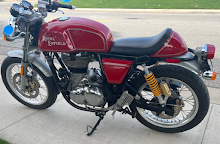











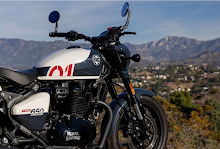
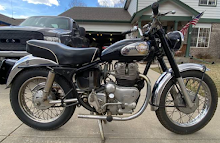




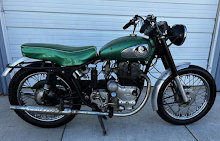
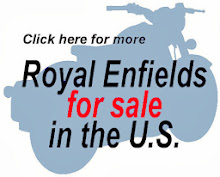





No comments:
Post a Comment